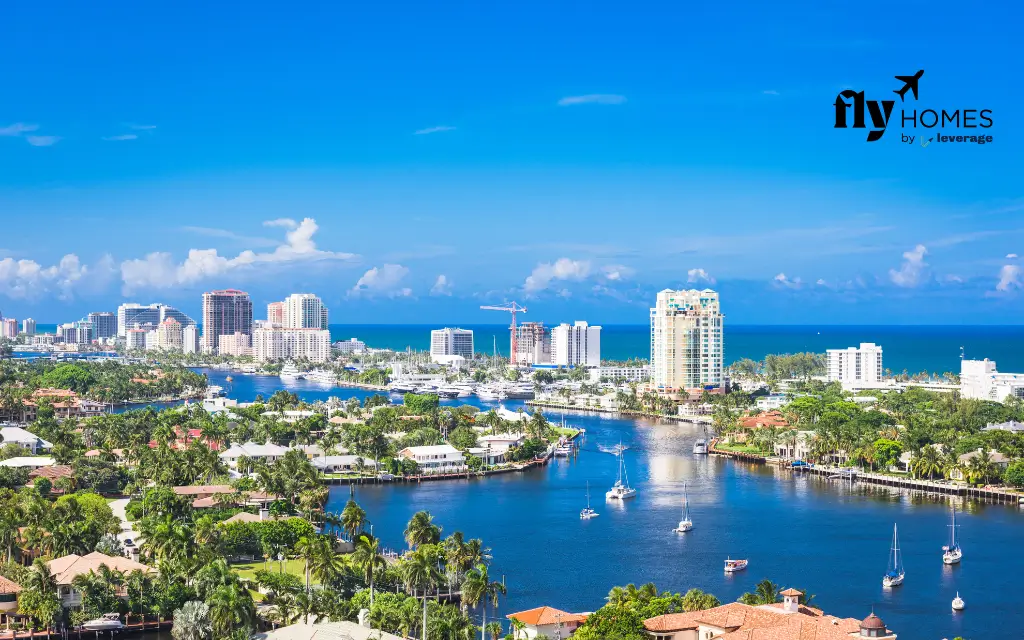If you’re dreaming of studying in Florida, it’s important to know what your living expenses will look like. The cost of living in Florida can vary depending on where you study, but with the right planning, it’s possible to make it work. Florida is a popular choice for students due to its warm climate and world-class universities.
In this guide, we’ll dive into the cost of living in Florida in 2025, covering everything from housing to food, so you can plan ahead and focus on making the most of your studies!
Table of contents
- What is the Cost of Living in Florida?
- Cost of Accommodation in Florida
- Cost of Studying in Florida
- Cost of Food in Florida
- Cost of Transportation in Florida
- Cost of Utilities in Florida
- Healthcare and Insurance Costs in Florida
- Entertainment and Leisure Cost
- Factors Affecting Cost of living in Florida
- Tips to Save Money While Living in Florida
- FAQs on Cost of living in Florida
What is the Cost of Living in Florida?
According to the LivingCost data, the average cost of living in Florida is USD 2,518, making it 1.14 times higher than the national average in the United States. Florida ranks as the 11th most expensive state and the 16th best state to live in the US .
The cost of living can vary significantly depending on the city and lifestyle choices. Overall, Florida tends to have a moderate cost of living compared to other states, but urban areas like Miami and Orlando can be pricier. Below is a table where you can check the overall cost of living in Florida:
| Expense Category | Estimated Monthly Cost of living in Florida |
| Accommodation | USD 800 – USD 2,500 |
| Tuition Fee | USD 500 – USD 1,700 (monthly) |
| Food Expenses | USD 250 – USD 400 |
| Transportation Costs | USD 50 – USD 150 |
| Utility Cost | USD 250 – USD 350 |
| Estimated cost of living in Florida | USD 1,800 – USD 5,000 |
Also Read:
- Affordable Beach Towns in Florida: 10 Places for Every Budget
- Check Out the Top 5 Museums in Florida
Cost of Accommodation in Florida
One of the biggest factors influencing the cost of living in Florida is housing. For international students, accommodation typically represents the largest portion of monthly expenses. Florida provides a diverse selection of living environments, from lively cities to peaceful beachside communities. To make living more affordable, consider choosing shared housing or a double occupancy apartment, which can significantly reduce your rent.
Check out the table below for some of the top cities with their average rent of 1-bedroom apartments and shared housing apartments as well. This table will provide you with an idea of the cost of accommodation in Florida.
| City | Average Rent (1-Bedroom) | Shared Housing (Per Person) |
| Miami | USD 2,500 | USD 800 – USD 1,200 |
| Orlando | USD 1,800 | USD 500 – USD 900 |
| Tampa | USD 1,600 | USD 400 – USD 800 |
| On-Campus | USD 3,000 – USD 10,000 (per year) | N/A |
Cost of Studying in Florida
Tuition fees make up one of the largest and most significant expenses when studying in Florida. As home to many top-tier and globally recognized universities, the state offers exceptional academic opportunities alongside an appealing lifestyle. However, it’s important to note that tuition costs play a major role in shaping your overall cost of living in Florida—higher fees can substantially raise your budget, while lower ones may ease financial pressure.
The choice of the course and the university you have chosen to pursue your dream impacts your cost of living directly. Check out the top 3 universities with their tuition fees and calculate your cost of living in Florida accordingly.
| Top Universities in Florida | Tuition Fees |
| University of Florida | USD 6,381 to USD 28,659 |
| University of Tampa | USD 21,810 to USD 29,820 |
| University of Miami | USD 55,036 to USD 75,330 |
Cost of Food in Florida
Food is an important part of the cost of living in Florida. Eating out often can get expensive, but it’s nice to treat yourself now and then. Florida has many Must-Visit Restaurants with different types of food, from fresh seafood to international dishes. You can also check out the Top Cafes in Florida for a quick meal or a coffee while studying. These places can make your time in Florida even better! Here’s a quick look at meal costs:
- Fast Food Meal: USD 10.2
- Lunch Menu: USD 19.3
- Dinner for 2: USD 81.2
To save money, we suggest cooking at home. It’s more affordable, healthier, and gives you control over what you eat. Cooking at home is a great way to enjoy tasty meals without breaking the bank! You can check the table below for some grocery items and their approximate costs in Florida:
| Grocery Item | Approx Cost (USD) |
| Milk, 1L | 1.13 |
| Bread, 0.5kg | 3.53 |
| Rice, 1kg | 4.16 |
| Eggs, x12 | 3.97 |
| Cheese, 1kg | 13 |
| Chicken Breast, 1kg | 11.1 |
| Apples, 1kg | 5.16 |
| Banana, 1kg | 1.67 |
| Oranges, 1kg | 4.68 |
| Tomato, 1kg | 4.74 |
| Potato, 1kg | 2.9 |
| Onion, 1kg | 3.24 |
| Water, 1L | 1.41 |
| Coca-Cola / Pepsi, 2L | 2.79 |
| Cold medicine, 1 week | 9.74 |
| Hair Shampoo | 5.4 |
| Toilet paper, 4 rolls | 4.44 |
| Toothpaste, 1 tube | 2.3 |
Cost of Transportation in Florida
Transportation in Florida can be quite manageable. Many universities offer shuttle services or have easy access to public transportation. Bus and tram fares are generally inexpensive, often around USD 2-USD 3 per ride. To reduce the cost of living in Florida you can go for the bus and tram passes that are offered especially to the international students. If you plan on using a car, factor in the cost of gas, insurance, and parking.
Florida typically offers gas prices that are lower than the national average, helping to keep transportation costs down. However, auto insurance—especially for younger drivers—can be on the expensive side. Below is a basic overview of the various transportation options available in Florida and their associated costs, all of which play a significant role in shaping the state’s overall cost of living in 2025.
| Mode of Transport | Cost |
| Bus | USD 1.76 (one-way ticket) |
| Trolley | USD 2 (one-way ticket) |
| Taxi | USD 2.70 per mile (one-way ticket) |
| Miami Monthly Transit Pass | USD 50 – USD 100 |
| Orlando Monthly Transit Pass | USD 50 – USD 100 |
| Gas Prices | USD 3.00 – USD 4.00 per gallon |
| Car Insurance | USD 1,500 – USD 2,500 annually |
Cost of Utilities in Florida
Utilities are another important component that contributes to the cost of living in Florida. It includes the cost of your phone bills, electricity bills, and even your internet bills. It is advisable to confirm with your student accommodation provider about the inclusion of the utilities in the rent of accommodation. Here is how much you’d ideally spend on utilities in Florida.
| Utility | Estimated Monthly Cost |
| Electricity | USD 150 – USD 250 |
| Water and Sewage | USD 50 – USD 100 |
| Internet and Cable | USD 60 – USD 100 |
Also Read:
Healthcare and Insurance Costs in Florida
Healthcare is an important aspect of the Cost of Living in Florida, especially for retirees and families. Florida offers excellent medical facilities, but healthcare can be expensive without proper insurance. Below we have mentioned the average healthcare cost and affordable healthcare options.
Average Healthcare Costs
- Health insurance premiums for individuals range from USD 300 to USD 700 per month, depending on the plan.
- A typical doctor’s visit costs between USD 100 and USD 200 without insurance.
- Prescription medications and specialist visits vary, but Florida has numerous programs to assist low-income residents.
Affordable Healthcare Options
- Florida offers Medicaid for eligible low-income individuals and families.
- Many counties provide community health clinics with reduced-cost services.
- Urgent care visits average USD 100 to USD 150, which is cheaper than an emergency room visit.
Entertainment and Leisure Cost
Studying hard is important, but it’s equally essential to take time to relax and enjoy yourself. Florida offers a variety of cultural experiences and unique attractions, from top-notch museums to famous festivals and concerts. You can also explore the top 7 Attractions in Panama City, Florida, Top Libraries in Florida, and Amazing Parks in Florida, including the Everglades and Anastasia State Park.
Many attractions provide student discounts, so don’t forget to carry your student ID with you to save on entry fees. Here’s a table of some entertainment and leisure costs in Florida:
| Item | Approx Cost (USD) |
| Gym Membership, 1 month | 40.2 |
| Cinema Ticket, 1 person | 14.1 |
| Haircut, simple | 20.9 |
| Brand Jeans | 50.6 |
| Brand Sneakers | 88.7 |
Factors Affecting Cost of living in Florida
Several factors influence how much a student spends while living in Florida. Understanding these can help in making smarter financial decisions:
- Location – Living costs vary widely between cities. Miami and Orlando are more expensive than smaller college towns like Gainesville or Tallahassee.
- Housing Choices – Renting an apartment off-campus can be cheaper than dorms, but location and roommates impact costs.
- Transportation – Owning a car comes with insurance, gas, and maintenance costs, while public transportation is often more affordable.
- Food & Dining Habits – Cooking at home is significantly cheaper than frequently eating out.
- Entertainment & Lifestyle – Florida offers plenty of attractions, but budgeting for entertainment (theme parks, nightlife, events) is crucial.
- Tuition & Fees – In-state tuition is lower than out-of-state tuition, and scholarships or financial aid can help reduce costs.
Tips to Save Money While Living in Florida
Here are some detailed and practical tips to help students save money while living in Florida, covering everything from transportation and food to entertainment and housing.
- Find Cheap Accommodation: Look for affordable housing options such as shared apartments or renting rooms in a house. Living with roommates can significantly reduce rent and utility costs.
- Find Student Discounts: Many restaurants, stores, and entertainment venues offer discounts for students. Always carry your student ID to take advantage of these offers.
- Cook at Home: Avoid expensive take-out by cooking meals at home. Meal prepping is a great way to save both time and money.
- Use Campus Resources: Take advantage of free campus events, recreational facilities, and libraries instead of spending money on outside entertainment.
- Use Public Transportation: Use buses or other public transport options to save on gas, parking fees, and maintenance costs associated with owning a car.
- Buy Used Textbooks: Purchase or rent used textbooks, or consider digital versions which are often cheaper than physical copies. Websites like Chegg or Amazon offer good deals.
- Look for Part-Time Work or Internships: Take on a part-time job or internship that offers flexible hours to help cover living expenses. Many student jobs on campus also offer additional benefits like free meals or parking.
FAQs on Cost of living in Florida
Florida’s cost of living is higher than the national average, especially in cities like Miami and Orlando, but lower than states like California and New York.
A shared apartment near universities costs $600 to $1,500 per month, depending on the city and proximity to campus.
Jacksonville, Tallahassee, and Gainesville offer more affordable housing compared to Miami or Tampa.
International students should budget approximately USD 200 to USD 300 per month for groceries. Costs can vary based on dietary preferences and shopping habits.
Yes, many universities offer scholarships, grants, and financial aid specifically for international students. Check with your university’s financial aid office or international student services for information on available financial assistance.
Saving money in Florida KW can be challenging due to its higher living costs, but you can reduce expenses by cooking at home, shopping locally, and taking advantage of free or low-cost outdoor activities.
Florida is more affordable than many other states like California or New York. However, major cities like Miami, Orlando, and Tampa can be costly, especially for rent and housing. Rural areas and smaller cities tend to be more affordable.
To save money, consider living in smaller towns or cities, shopping at discount grocery stores, cooking at home, and using public transportation when possible. You can also take advantage of student discounts at attractions and entertainment venues.
Monthly utility costs range from $130 to $250, with higher expenses in the summer due to AC usage.
Yes, major cities like Miami, Orlando, and Tampa have public transportation, but most areas require a car.
Yes, Florida has a growing remote work community, no state income tax, and several coworking spaces.
Hope you liked reading about the cost of living in Florida. Reach out to Fly Homes now at 1800572118 to secure the finest accommodation abroad.
Follow Us on Social Media




























